Business Operations Report: Teamwork, Leadership, and Customer Service
VerifiedAdded on 2020/10/23
|5
|758
|235
Report
AI Summary
This report provides an overview of key aspects of business operations. It begins with an examination of team leadership roles and responsibilities, followed by a discussion of team development stages and training events. The report then assesses three motivation theories (Maslow's Hierarchy, Expectancy Theory, and Herzberg's Two-Factor Theory) and explores different leadership styles (Transactional and Transformational). Furthermore, it analyzes the impact of customer service on business success, including building customer loyalty and promoting the business through positive word-of-mouth. The report also highlights the benefits of customer profiling in understanding market potential and improving targeted marketing efforts. The report concludes with a list of references including books, journals and online resources.
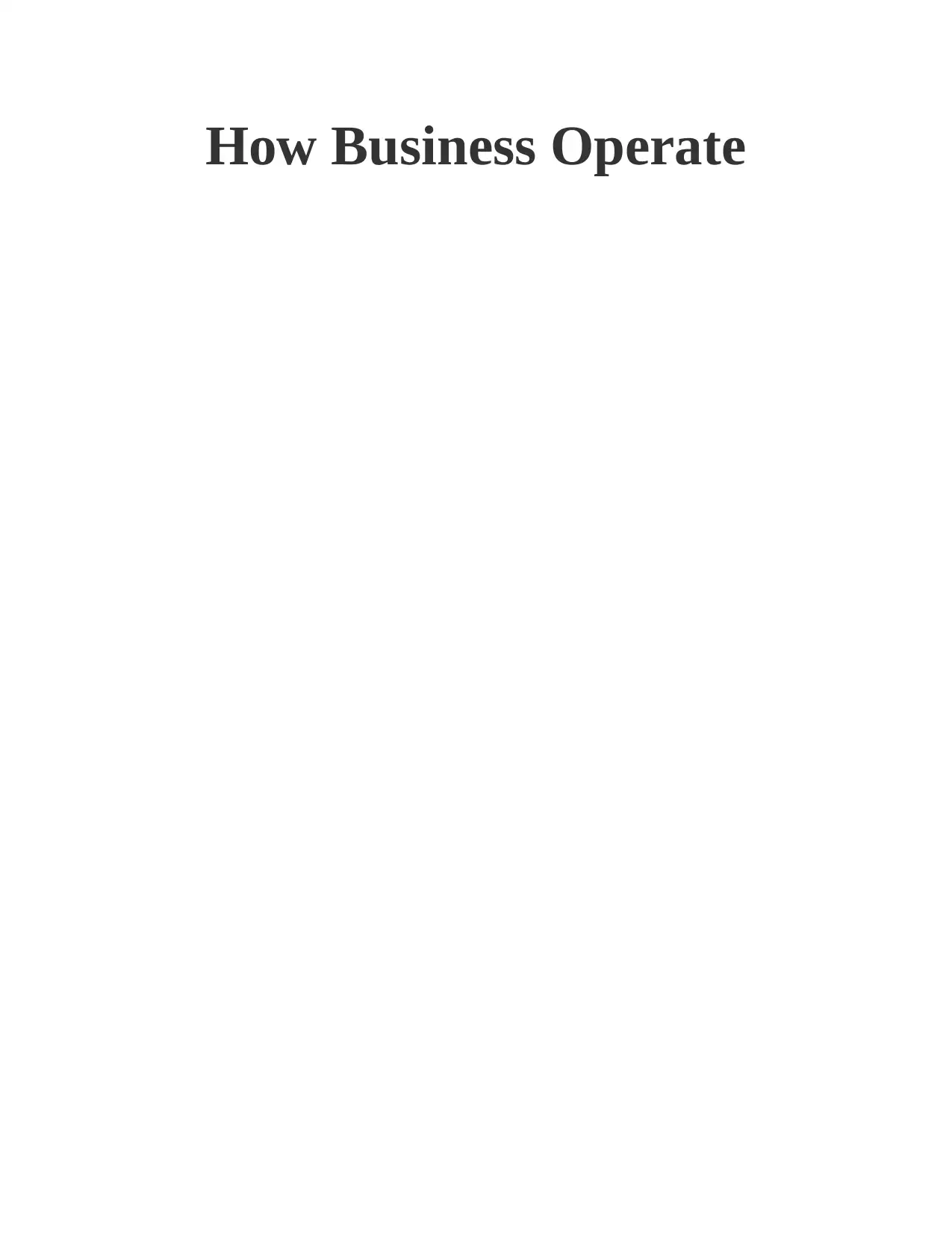
How Business Operate
Paraphrase This Document
Need a fresh take? Get an instant paraphrase of this document with our AI Paraphraser
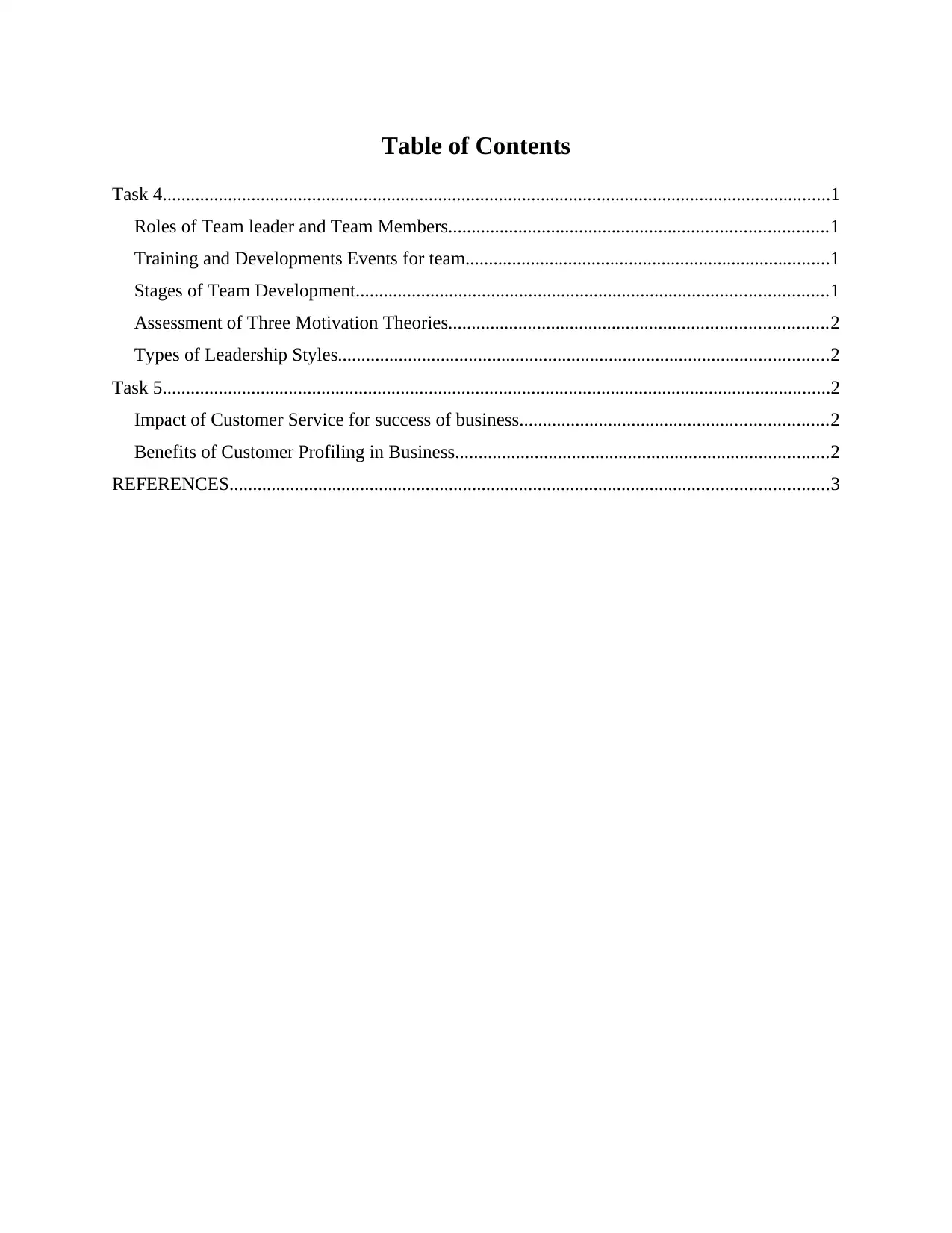
Table of Contents
Task 4...............................................................................................................................................1
Roles of Team leader and Team Members.................................................................................1
Training and Developments Events for team..............................................................................1
Stages of Team Development.....................................................................................................1
Assessment of Three Motivation Theories.................................................................................2
Types of Leadership Styles.........................................................................................................2
Task 5...............................................................................................................................................2
Impact of Customer Service for success of business..................................................................2
Benefits of Customer Profiling in Business................................................................................2
REFERENCES................................................................................................................................3
Task 4...............................................................................................................................................1
Roles of Team leader and Team Members.................................................................................1
Training and Developments Events for team..............................................................................1
Stages of Team Development.....................................................................................................1
Assessment of Three Motivation Theories.................................................................................2
Types of Leadership Styles.........................................................................................................2
Task 5...............................................................................................................................................2
Impact of Customer Service for success of business..................................................................2
Benefits of Customer Profiling in Business................................................................................2
REFERENCES................................................................................................................................3
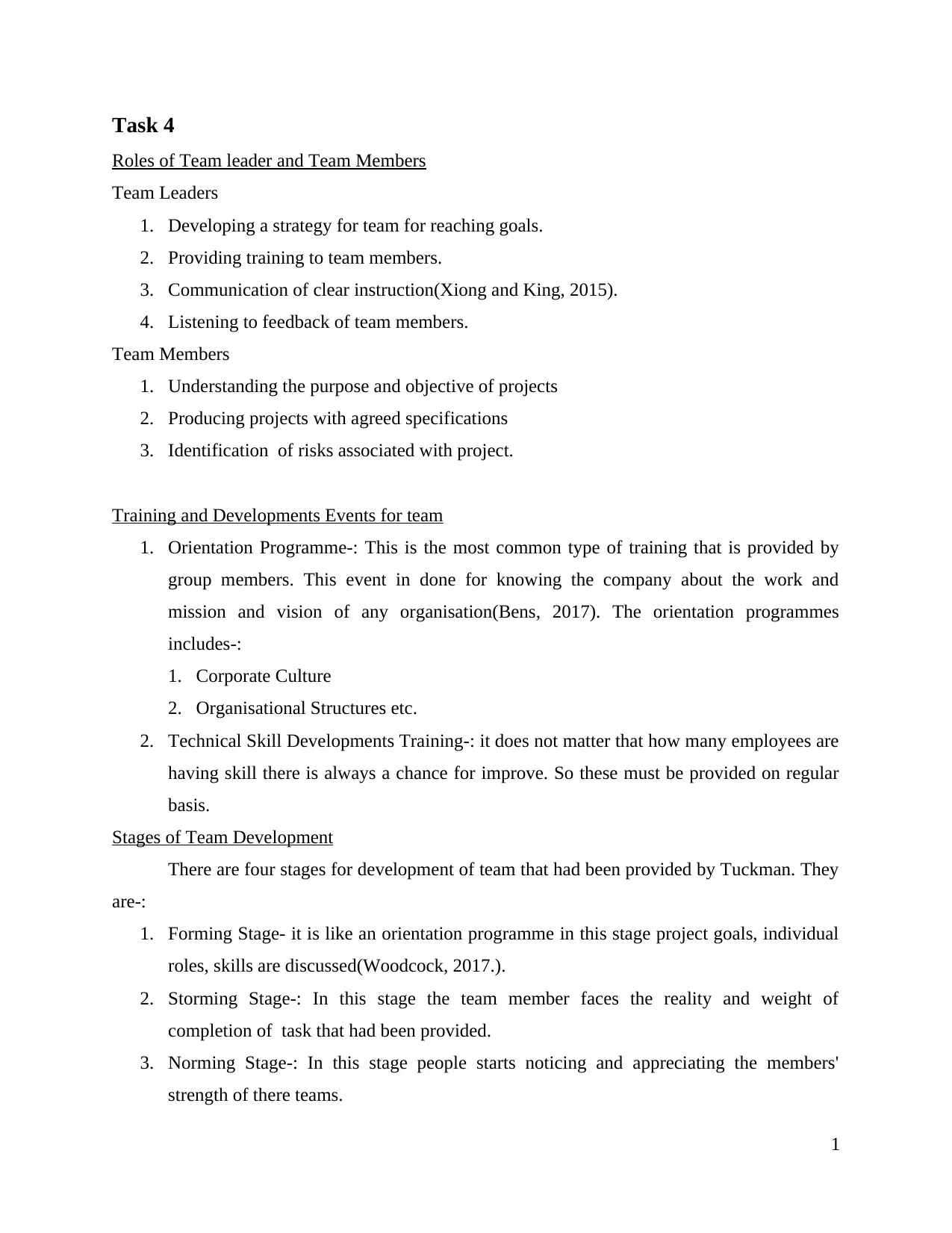
Task 4
Roles of Team leader and Team Members
Team Leaders
1. Developing a strategy for team for reaching goals.
2. Providing training to team members.
3. Communication of clear instruction(Xiong and King, 2015).
4. Listening to feedback of team members.
Team Members
1. Understanding the purpose and objective of projects
2. Producing projects with agreed specifications
3. Identification of risks associated with project.
Training and Developments Events for team
1. Orientation Programme-: This is the most common type of training that is provided by
group members. This event in done for knowing the company about the work and
mission and vision of any organisation(Bens, 2017). The orientation programmes
includes-:
1. Corporate Culture
2. Organisational Structures etc.
2. Technical Skill Developments Training-: it does not matter that how many employees are
having skill there is always a chance for improve. So these must be provided on regular
basis.
Stages of Team Development
There are four stages for development of team that had been provided by Tuckman. They
are-:
1. Forming Stage- it is like an orientation programme in this stage project goals, individual
roles, skills are discussed(Woodcock, 2017.).
2. Storming Stage-: In this stage the team member faces the reality and weight of
completion of task that had been provided.
3. Norming Stage-: In this stage people starts noticing and appreciating the members'
strength of there teams.
1
Roles of Team leader and Team Members
Team Leaders
1. Developing a strategy for team for reaching goals.
2. Providing training to team members.
3. Communication of clear instruction(Xiong and King, 2015).
4. Listening to feedback of team members.
Team Members
1. Understanding the purpose and objective of projects
2. Producing projects with agreed specifications
3. Identification of risks associated with project.
Training and Developments Events for team
1. Orientation Programme-: This is the most common type of training that is provided by
group members. This event in done for knowing the company about the work and
mission and vision of any organisation(Bens, 2017). The orientation programmes
includes-:
1. Corporate Culture
2. Organisational Structures etc.
2. Technical Skill Developments Training-: it does not matter that how many employees are
having skill there is always a chance for improve. So these must be provided on regular
basis.
Stages of Team Development
There are four stages for development of team that had been provided by Tuckman. They
are-:
1. Forming Stage- it is like an orientation programme in this stage project goals, individual
roles, skills are discussed(Woodcock, 2017.).
2. Storming Stage-: In this stage the team member faces the reality and weight of
completion of task that had been provided.
3. Norming Stage-: In this stage people starts noticing and appreciating the members'
strength of there teams.
1
⊘ This is a preview!⊘
Do you want full access?
Subscribe today to unlock all pages.

Trusted by 1+ million students worldwide
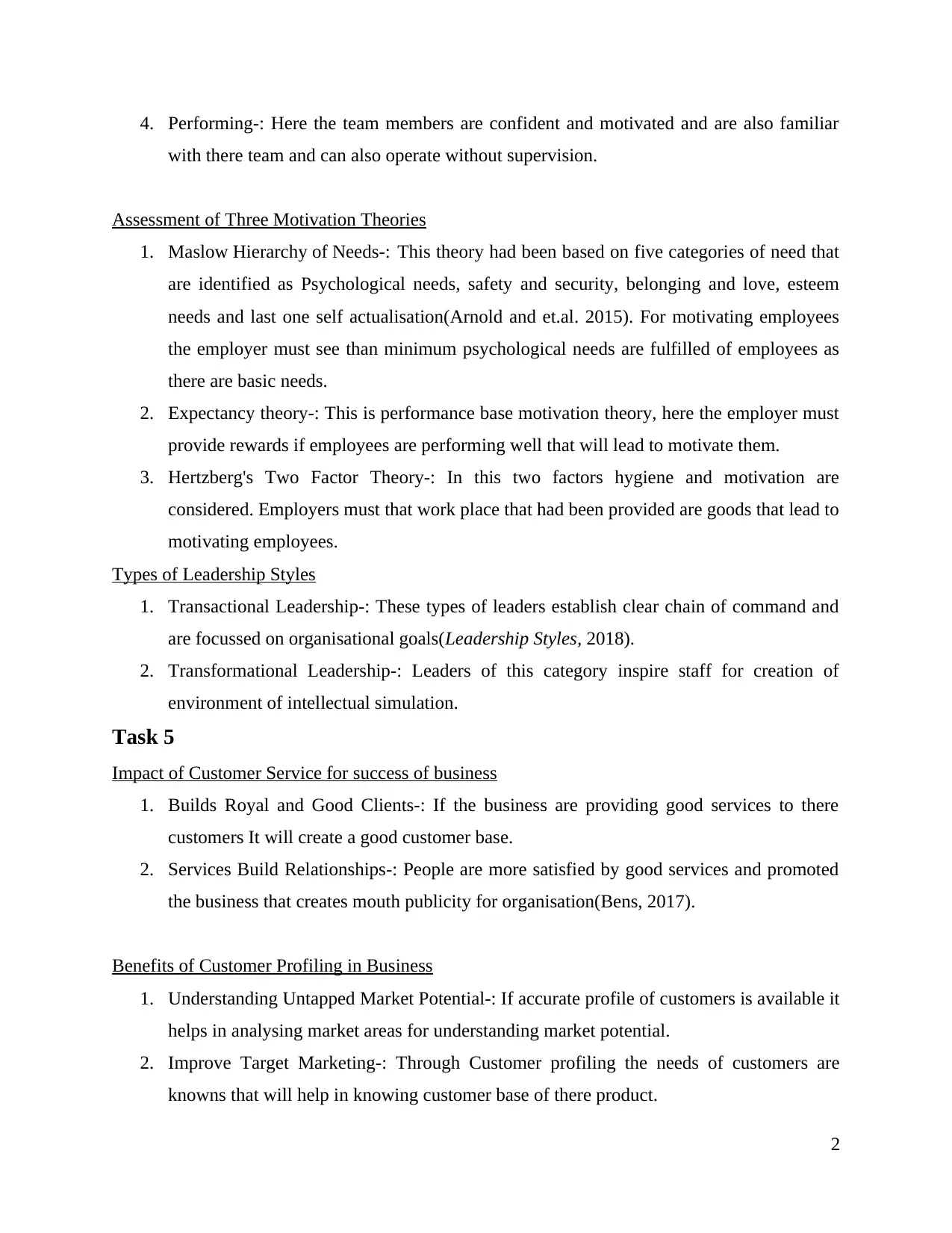
4. Performing-: Here the team members are confident and motivated and are also familiar
with there team and can also operate without supervision.
Assessment of Three Motivation Theories
1. Maslow Hierarchy of Needs-: This theory had been based on five categories of need that
are identified as Psychological needs, safety and security, belonging and love, esteem
needs and last one self actualisation(Arnold and et.al. 2015). For motivating employees
the employer must see than minimum psychological needs are fulfilled of employees as
there are basic needs.
2. Expectancy theory-: This is performance base motivation theory, here the employer must
provide rewards if employees are performing well that will lead to motivate them.
3. Hertzberg's Two Factor Theory-: In this two factors hygiene and motivation are
considered. Employers must that work place that had been provided are goods that lead to
motivating employees.
Types of Leadership Styles
1. Transactional Leadership-: These types of leaders establish clear chain of command and
are focussed on organisational goals(Leadership Styles, 2018).
2. Transformational Leadership-: Leaders of this category inspire staff for creation of
environment of intellectual simulation.
Task 5
Impact of Customer Service for success of business
1. Builds Royal and Good Clients-: If the business are providing good services to there
customers It will create a good customer base.
2. Services Build Relationships-: People are more satisfied by good services and promoted
the business that creates mouth publicity for organisation(Bens, 2017).
Benefits of Customer Profiling in Business
1. Understanding Untapped Market Potential-: If accurate profile of customers is available it
helps in analysing market areas for understanding market potential.
2. Improve Target Marketing-: Through Customer profiling the needs of customers are
knowns that will help in knowing customer base of there product.
2
with there team and can also operate without supervision.
Assessment of Three Motivation Theories
1. Maslow Hierarchy of Needs-: This theory had been based on five categories of need that
are identified as Psychological needs, safety and security, belonging and love, esteem
needs and last one self actualisation(Arnold and et.al. 2015). For motivating employees
the employer must see than minimum psychological needs are fulfilled of employees as
there are basic needs.
2. Expectancy theory-: This is performance base motivation theory, here the employer must
provide rewards if employees are performing well that will lead to motivate them.
3. Hertzberg's Two Factor Theory-: In this two factors hygiene and motivation are
considered. Employers must that work place that had been provided are goods that lead to
motivating employees.
Types of Leadership Styles
1. Transactional Leadership-: These types of leaders establish clear chain of command and
are focussed on organisational goals(Leadership Styles, 2018).
2. Transformational Leadership-: Leaders of this category inspire staff for creation of
environment of intellectual simulation.
Task 5
Impact of Customer Service for success of business
1. Builds Royal and Good Clients-: If the business are providing good services to there
customers It will create a good customer base.
2. Services Build Relationships-: People are more satisfied by good services and promoted
the business that creates mouth publicity for organisation(Bens, 2017).
Benefits of Customer Profiling in Business
1. Understanding Untapped Market Potential-: If accurate profile of customers is available it
helps in analysing market areas for understanding market potential.
2. Improve Target Marketing-: Through Customer profiling the needs of customers are
knowns that will help in knowing customer base of there product.
2
Paraphrase This Document
Need a fresh take? Get an instant paraphrase of this document with our AI Paraphraser
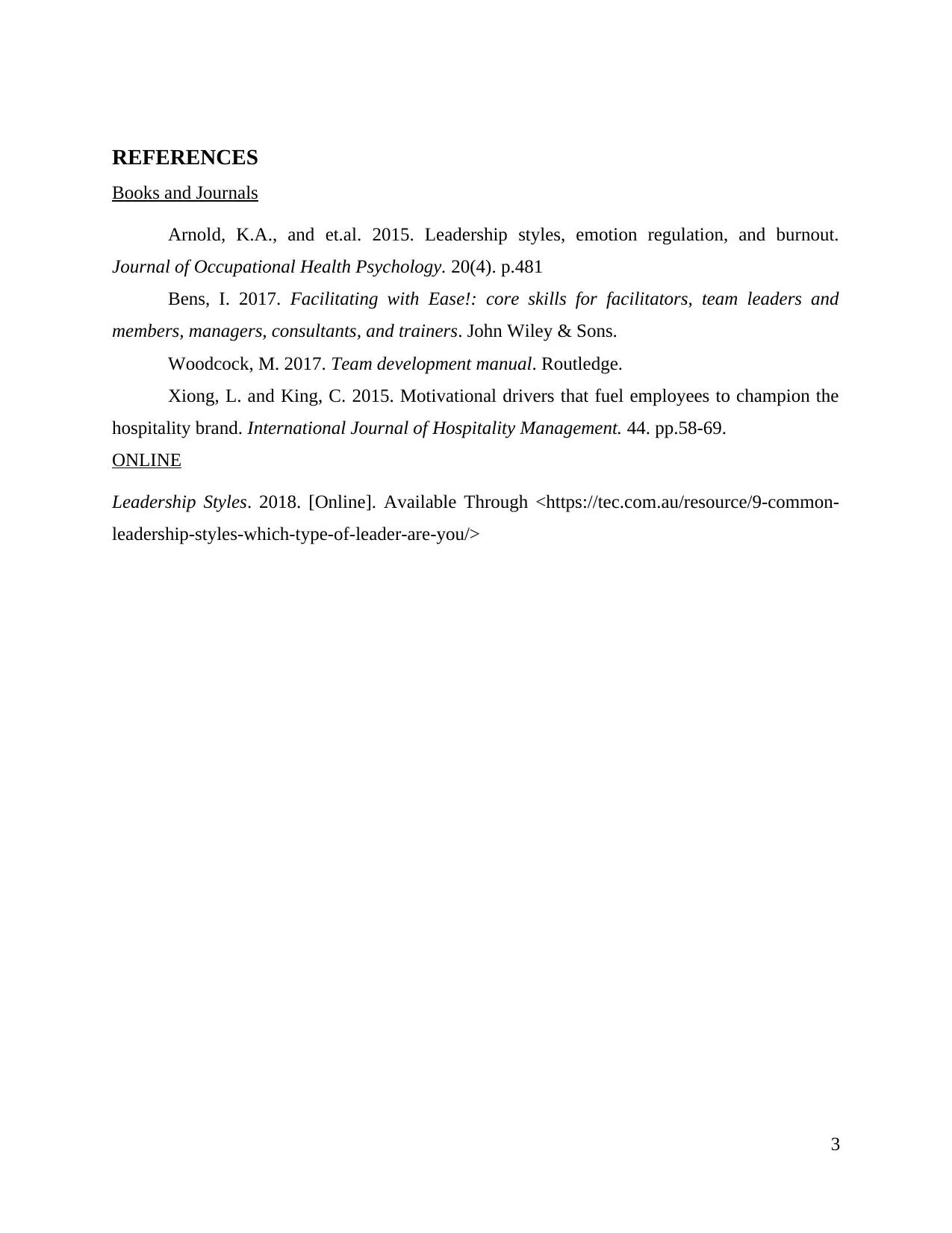
REFERENCES
Books and Journals
Arnold, K.A., and et.al. 2015. Leadership styles, emotion regulation, and burnout.
Journal of Occupational Health Psychology. 20(4). p.481
Bens, I. 2017. Facilitating with Ease!: core skills for facilitators, team leaders and
members, managers, consultants, and trainers. John Wiley & Sons.
Woodcock, M. 2017. Team development manual. Routledge.
Xiong, L. and King, C. 2015. Motivational drivers that fuel employees to champion the
hospitality brand. International Journal of Hospitality Management. 44. pp.58-69.
ONLINE
Leadership Styles. 2018. [Online]. Available Through <https://tec.com.au/resource/9-common-
leadership-styles-which-type-of-leader-are-you/>
3
Books and Journals
Arnold, K.A., and et.al. 2015. Leadership styles, emotion regulation, and burnout.
Journal of Occupational Health Psychology. 20(4). p.481
Bens, I. 2017. Facilitating with Ease!: core skills for facilitators, team leaders and
members, managers, consultants, and trainers. John Wiley & Sons.
Woodcock, M. 2017. Team development manual. Routledge.
Xiong, L. and King, C. 2015. Motivational drivers that fuel employees to champion the
hospitality brand. International Journal of Hospitality Management. 44. pp.58-69.
ONLINE
Leadership Styles. 2018. [Online]. Available Through <https://tec.com.au/resource/9-common-
leadership-styles-which-type-of-leader-are-you/>
3
1 out of 5
Related Documents
Your All-in-One AI-Powered Toolkit for Academic Success.
+13062052269
info@desklib.com
Available 24*7 on WhatsApp / Email
![[object Object]](/_next/static/media/star-bottom.7253800d.svg)
Unlock your academic potential
Copyright © 2020–2025 A2Z Services. All Rights Reserved. Developed and managed by ZUCOL.





